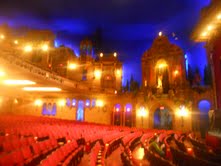Standing Ovation: Louisville Palace
Before high-rises, Fourth Street Live!, and the KFC YUM! Center carved Louisville, Kentucky’s signature skyline, and fast-paced interstates zipped through the center, the city’s attention to the arts were a sign of the future urban sophistication for the home of the Kentucky Derby. What is now known as the Louisville Palace is undeniably an anchor, icon, and tourist attraction for Downtown Louisville. “The Palace” has stood the test of time—a lifetime of time— on 4th Street. The theater has shown the importance of uniqueness for not only the arts, but also for a city’s character by being resilient.
Built in 1928, on 625 S. 4th Street to be precise, the Louisville Palace was not always named as such. The theater was originally called Loew’s Theater on its September 1, 10:15 a.m. Grand Opening. The venue operated as a double-decker, silent film house and served as the local film outlet for Columbia and Metro-Goldwin-Mayer.
The comedy The Old Gray Horse and featured movie Excess Baggage (with sound) welcomed record crowds for Grand Opening. Governor Fleming D. Sampson and Mayor William B. Harrison were in attendance, as well as Jan Garber and his band featuring Haden Read on the Wurlitzer. Louisville residents had the pleasure of walking off of 4th Street into a 276-bulb Marquee and step up to a ticket booth (now called the Kiosk) made of marble and cast iron.
Loew’s Theater’s design is unique coast to coast, but especially to Louisville. Architect John Eberson designed the theater as part of a series of atmospheric theaters, with 100 movie palaces in dozens of states and even Caracas, Venezuela, Mexico City, and Perth, Sydney, and Melbourne, Australia. His style deeply reflected Spanish Baroque 17th to 18th century with an emphasis on the experience of being outside. For several years, “clouds” were projected onto Loew’s Theater’s ceiling by machines called Brenographs. The “stars” in the ceiling are small lights arranged from a constellation chart, likely to such be of an autumn sky. Reproductions of Renaissance originals and locally made statues of Michelangelo’s David further give the main theater space the feel of a Spanish garden at night. There are six of the seven original statues remaining. A statue was stolen December 2, 1962. The thief was never caught.
The Faces Lobby boasts 139 faces on the ceiling in no apparent order. There are twelve repeating faces of each Apollo, Bach, Beethoven, Dante, Handle, Listz, Moliere, Mozart, Schubert, Shakespeare, Socrates, and Wagner with two other faces that appear only once, one of which is Eberson himself. The chandeliers are not the originals from the 1930’s, but rather restored. The center one weighs about 300 lbs.
Loew’s Theater’s seating capacity was originally 3,300, but such changed along with the name of the theater itself: Loew’s Theater (1928), Loew’s United Artist Theater (1948), United Artist Theater (mid-1950’s), United Artists/Penthouse Theater (1963), and finally the Louisville Palace (1978). Shortly after the theater took on the name Louisvillians know it as today, it experienced commercial turbulence and closed. John Seigel purchased and renovated the building in 1978 and invested 4.4 million dollars towards the renovations. Louisville Palace opened again in 1981 and was open off and on until 1985 when it remained close for 9 years. The Palace Theatre was placed on the Ten Most Endangered Buildings List for Downtown Louisville in 1992, as it is one of only a dozen of Eberson’s atmospheric designs still standing. The theater reopened in 1994 with the current seating capacity of 2750 to a sellout concert featuring Yanni.
“The Palace” has gone on to host some of the biggest names in the entertainment industry. Among them are Aretha Franklin, rapper Kendrick Lamar, Hall & Oates, John Prine, Diana Ross, and comedian/actor Robin Williams. Actor and Louisville-native Victor Mature premiered his Hollywood films at the theater.
The venue has also added more unique sophistication to Downtown Louisville by embracing other types of events the city enjoys. In July and August on Friday and Saturday nights, the theater shows black and white films. The annual movie showing is called The Classic Summer Movie Theater, admission is five dollars, and each year the films have a different theme.
With the help of a renovated stage, the Louisville Palace hosts ceremonies and weddings, corporate presentations and meetings, on-stage dinners, receptions, fundraisers, and social events. The theater showcases a local, monthly concert series called Faces at The Palace where the Faces Lobby is turned into a mini-concert hall. Faces at The Palace has featured many popular local bands, such as Bodecco, Trophy Wives, The Lady Birds, Kentucky Salsa All Stars, and Field of Kings, among others.
The Louisville Palace has proven itself a necessity to Downtown’s history and Louisville’s culture and urban sophistication. The Live Nation-owned theater has 80-100 shows and concerts a year and 30-40 special or private events. A staff of eight keeps an undeniably valuable piece of Louisville’s history and uniqueness accessible to future generations.



